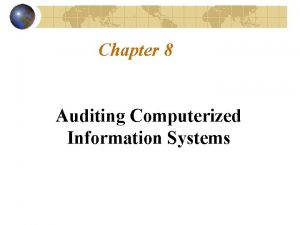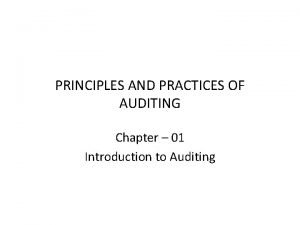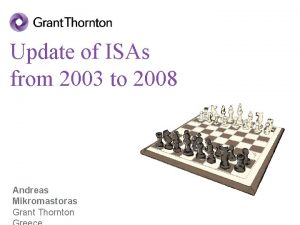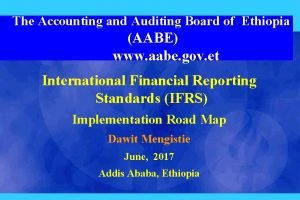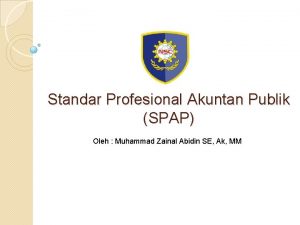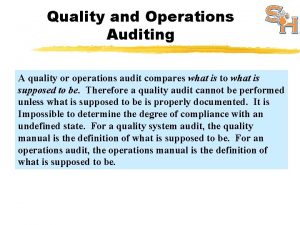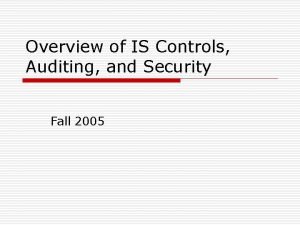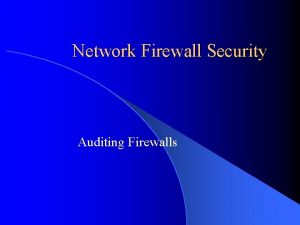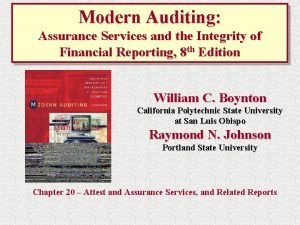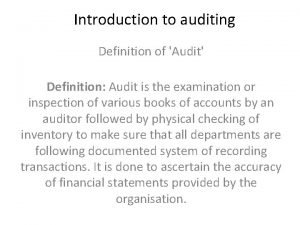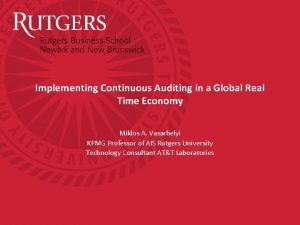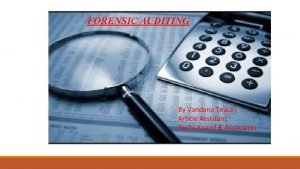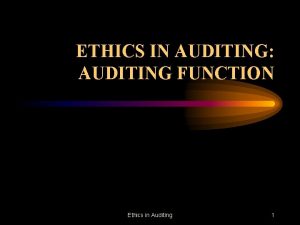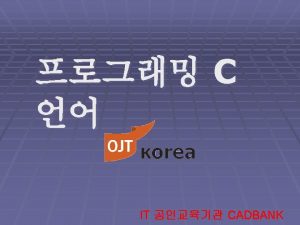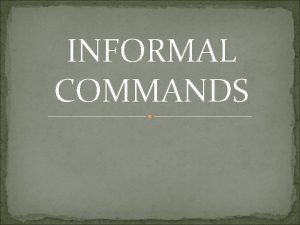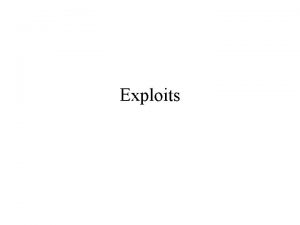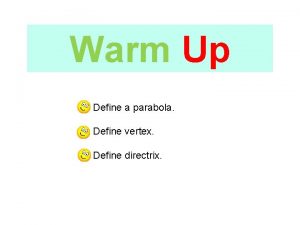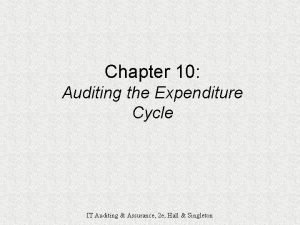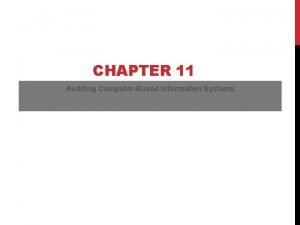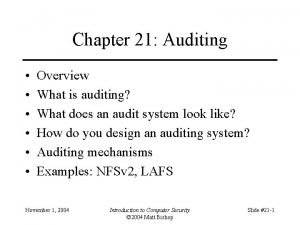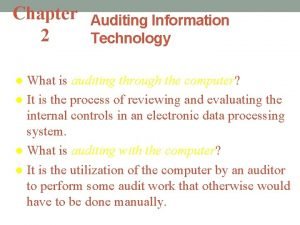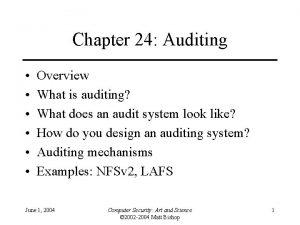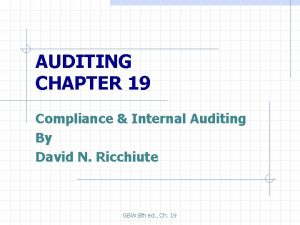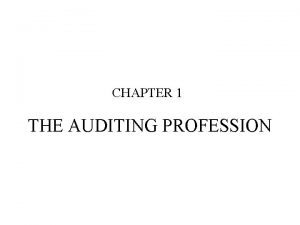Chapter 1 Importance of Auditing Define Auditing A























- Slides: 23

Chapter 1 Importance of Auditing

Define Auditing “A systematic process of objectively obtaining and evaluating evidence regarding assertions about economic actions and events to ascertain the degree of correspondence between those assertions and established criteria and communicating the results to interested users.

What is auditing? Auditing is both more and less than public accounting n More because it includes internal and operational auditing, governmental auditing, and other services that evaluate and report on managerial performance n Less because public accounting firms provide a variety of other assurance and non-audit services n

Free Market Economy A free market economy exists only if accurate, reliable data is available n Auditors contribute to an effective capital market by providing independent evaluations about the reliability of an organization's financial statements or the efficiency and effectiveness of various aspects of its performance n

Auditing is all about evidence n n n The auditor gathers evidence to determine if the client's processes are working correctly, its financial data are recorded and presented correctly, and its financial statements as a whole are fairly presented. This implies that-the process of auditing is to gather and evaluate evidence to test assertions the audit process is systematic the auditor must be independent of the entity audited and the process followed in gathering evidence must be unbiased

Discuss Management & GAAP n n When management prepares financial statements, they assert that those statements are fairly presented in accordance with GAAP is the criteria by which "fairness" of financial statement presentation is judged However, the interpretation and application of GAAP is difficult The auditor's task is to determine whether the financial statements present fairly in accordance with GAAP

Comment on Communication of audit results to management and third parties completes the audit process n To minimize misunderstandings, this communication follows a prescribed format that states the responsibilities of both management and the auditor, summarizes the audit process, and expresses the auditor's opinion on the financial statements n

Define an Unqualified Audit Report & List Its Three Paragraphs Most audits result in reports that do not contain reservations about the fair presentation of the financial statements. 1. Introductory paragraph - identifies company, statements, and accounting periods examined, management's responsibility for the financial statements, auditor's responsibility for expressing an opinion 2. Scope paragraph - performance of the audit in accordance with GAAS and limitations of the audit 3. Opinion paragraph - statements present fairly, in all material respects, in conformity with GAAP n

Discuss the accounting profession’s decade of unprecedented turmoil & change 1. The failure of one of the largest public accounting firms (Andersen) 2. Four of the largest bankruptcies ever - each in companies where financial statement misrepresentation had taken place 3. Billions of investment and retirement dollars lost 4. Perception that auditors were not independent from their clients

What was Congress’ response? Passing the Sarbanes-Oxley Act of 2002. That focused on five critical improvements in how financial information is presented. 1. Improved corporate governance 2. Reporting on internal controls 3. Greater independence of audit function 4. Acknowledgment of greater audit responsibility 5. Audit standard setting moved to a new quasi -public organization n

Improved Corporate Governance n n n The lack of corporate governance was a major factor in business failures; most notably, a failure of Boards of Directors to oversee management, and effectively utilize the audit function. Sarbanes requires Boards of Directors be independent of the organization and exercise oversight over management and the audit function Further, the Board of Directors, through its audit committee, is the "client" of the public accounting firm.

Reporting on Internal Controls In most cases of major fraud, companies had poor internal controls over financial reporting n Sarbanes requires the CEO and CFO of SEC registered companies to assess and publicly report on the quality of its internal controls over financial reporting n

Greater Independence of Audit Function n n n The audit function must be independent and objective if assurances are to be trusted by third parties. Auditor independence has been strengthened by requiring: 1. The audit committee has the authority to hire and fire the external auditors 2. Mandatory rotation of the audit engagement partner every five years 3. Consulting work cannot be performed for audit clients 4. Increased oversight of potential independence conflicts by the audit committee Non-public companies and smaller audit firms are not required to follow all these guidelines

Audit Standard Setting Moved n n The public lost confidence in the ability of the profession to serve the public interest. Sarbanes created the Public Company Accounting Oversight Board (PCAOB). The PCAOB has authority to develop audit standards for audits of publicly traded companies. The PCAOB is also charged with performing peer review of all public accounting firms that perform audits of public companies. The PCAOB is comprised of five public members appointed by the SEC. No more than two members can be CPAs.

Who Are the Providers of Assurance Services? n The Public Accounting Profession n The Internal Audit Profession Governmental Audit Profession

The Public Accounting Profession n n More than 45, 000 CPA firms in the United States, ranging sole-practitioners to large multinationals such as the Big 4. These firms provide a variety of services in the areas of assurance and financial statement services, tax planning and compliance, and consulting The SEC has prohibited accounting firms from providing most consulting services to public companies that they audit Such restriction on services has not been specified by the AICPA or regulatory authorities for public accounting firms that do not audit SEC registered clients

Requirements to Enter the Public Accounting Profession n Accounting and Auditing Expertise - in addition to technical knowledge, auditor must have sound conceptual understanding of financial reporting and auditing Knowledge of Business and its Risks auditor must understand the basic structure of a business in order to identify significant risks affecting the client Understanding Accounting System Complexity - auditor must understand the challenges posed in a system in which traditional source documents do not exist

Organization of CPA Firms n n n The organizational hierarchy of CPA firms has been described as a pyramidal structure. Partners (or owners) are at the top and are responsible for the overall conduct of each audit Next, managers review the detailed audit work performed by staff auditors Seniors are responsible for overseeing much of the day-to-day activities on a specific audit Staff auditors perform the basic, detailed audit work. Partners and managers may be involved in a number of audit engagements being conducted simultaneously; seniors and staff are usually assigned to only one audit at a time

The Internal Audit Profession n n Internal auditing is defined as " an independent, objective assurance and consulting activity designed to add value and improve an organization's operations. It helps an organization accomplish its objectives by bringing a systematic, disciplined approach to evaluate and improve the effectiveness of risk management, control, and governance processes. "

Internal auditors add value to an organization by n n n evaluating processes to identify and management risk, develop and implement effective internal controls assuring management and the Board of Directors on the company's compliance with policies or regulatory requirements, or the effectiveness of processes and operations providing consulting services such as analyzing problems and identifying potential solutions performing operational audits designed to evaluate the effectiveness, economy, and efficiency with which resources are employed Its broad scope makes internal auditing an excellent training ground for future management positions

Governmental Auditing Profession Employed by various Federal, state, and local agencies n Governmental auditors perform all the types of audits that internal auditors perform including compliance, operational, and performance audits n

Professional and Regulatory Organizations n n n The PCAOB established as part of the Sarbanes. Oxley Act of 2002 has authority to set auditing standards for audits of public companies and to perform quality reviews of all registered CPA firms The SEC oversees the PCAOB and all companies publicly traded on the U. S. capital markets. It has the authority to establish GAAP for publicly traded companies, and to prosecute companies who violate SEC laws The AICPA has long served as the primary governing organization of the public accounting profession. It provides a variety of continuing education programs and administers the Uniform CPA Examination. Membership in the AICPA is voluntary

Professional and Regulatory Organizations n n n The State Boards of Accountancy are responsible for certifying and licensing CPAs in their state. While all state boards require passage of the Uniform CPA Examination, education and experience requirements vary by state. The Institute of Internal Auditors issued internal auditing standards and administers the Certified Internal Auditor program The U. S. General Accounting Office is the nonpartisan audit agency for Congress. The GAO develops auditing standards for governmental audits.
 Auditing standards differ from auditing procedures
Auditing standards differ from auditing procedures Manual auditing and computerized auditing
Manual auditing and computerized auditing What are the objectives of supervision
What are the objectives of supervision Audit note book
Audit note book Advantages of auditing
Advantages of auditing Auditing revenue process
Auditing revenue process Chapter 9 auditing the revenue cycle
Chapter 9 auditing the revenue cycle Attestation vs audit
Attestation vs audit Chapter 9 auditing sales and receivables
Chapter 9 auditing sales and receivables Chapter 8 review questions lord of the flies
Chapter 8 review questions lord of the flies Chapter 10 lesson 1 health
Chapter 10 lesson 1 health International standard on auditing 240
International standard on auditing 240 The word audit is derived from the latin word for what name
The word audit is derived from the latin word for what name Accounting & auditing board of ethiopia
Accounting & auditing board of ethiopia Hirarki standar auditing
Hirarki standar auditing Operations auditing
Operations auditing What is auditing around the computer
What is auditing around the computer A history and survey of network firewalls
A history and survey of network firewalls Modern auditing & assurance services
Modern auditing & assurance services Voucher in auditing
Voucher in auditing Introduction to audit
Introduction to audit Continuous auditing definition
Continuous auditing definition Critical point auditing
Critical point auditing Information technology auditing
Information technology auditing

